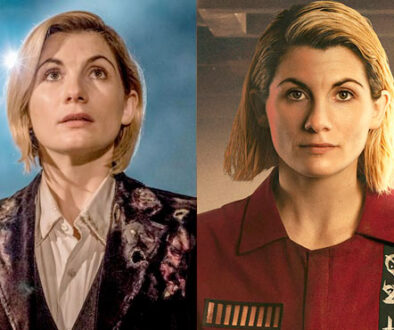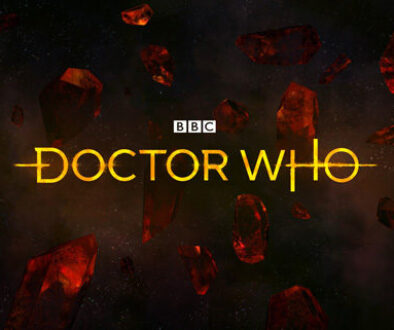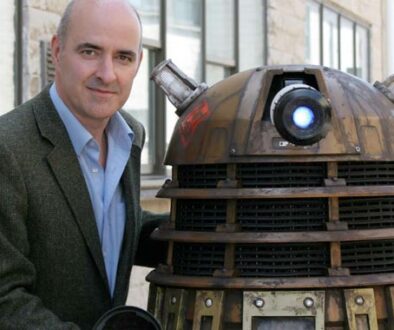“Nikola Tesla’s Night of Terror” Review – Celebrating the “Science” in “Science Fiction”
Clint Hassell gives his SPOILER-filled commentary on the fourth episode of Series 12.

Note: this review contains full SPOILERS for episode 4 of Series 12.
Doctor Who’s “historical” episodes are rarely based in fact, instead drawing most of their entertainment value from their stunt casting of historical figures and a narrative that inevitably weaves an alien threat into a noted real-life event. While “Nikola Tesla’s Night of Terror” does cast Goran Višnjić as “total genius” Nikola Tesla and proffers Tesla’s hearing “messages from another planet” as signals from an invading race of alien scavengers, the episode overcomes these tropes by not only imbuing its storyline with a reverence from the titular inventor’s sense of wonder but also by mining that spirit of discovery to further develop the series’ core cast of characters.
One notable aspect of writer Nina Metivier’s script is how effortlessly it includes a multitude of facts regarding Nikola Tesla’s life. Tesla’s work as a consultant for the Niagra Falls Hydraulic Power & Manufacturing Company; his research into early radiography; his invention of radio-controlled boats; and his ideas about radar and worldwide energy transmission are all mentioned. Tesla did conceive of a “mechanism for photographing thoughts,” patent an “apparatus for producing ozone,” and develop a “prototype death ray,” though, in reality, the latter was a multidecade resistance box and looked like a table-top radio with lots of knobs on it – – not like a raygun. The “Mr. Morgan” that invested in Wardenclyffe Tower? That’d be noted Wall Street corporate financier J. P. Morgan. Dorothy Skerrit and Harold Green? Both existed, though the episode misspells her last name and his last name was actually “Brown.” Yes, it was rumored that Tesla’s research caused earthquakes, he did squabble over patent rights to an improved system for radio tuning (not transmission) with Guglielmo Marconi, and he did claim to have intercepted “messages from another planet” (most likely, Tesla intercepted Marconi’s early efforts at long-distance radio transmission; the media specified Tesla’s messages as coming from Mars). While it’s a stretch to say that Tesla died with “no fame” – – he was featured on the cover of Time, in 1931, to honor his 75th birthday – – it is true that he died impoverished, having spent the millions he earned from his many patents regarding alternating electrical current to further the development of his later ideas.
The importance of honoring Nikola Tesla’s real-life accomplishments – – fantastic as they seem – – becomes apparent as Tesla encounters the Doctor. Rather than focusing on his fascination with the ethereal aspects of the Time Lord, the script roots his character and his motivations in the factual, hailing his sense of ingenuity and his enthusiasm for discovery as equal to the Doctor’s renown sense of adventure and compassion. “You’re an inventor!” Tesla cries, seeing the Doctor’s sonic screwdriver, “You can understand how it feels . . . when you have an idea . . . to make it real. I don’t think there is any greater thrill.” More than any episode in Doctor Who’s revived era, “Nikola Tesla’s Night of Terror” celebrates the “science” in the series’ science fiction premise.

The episode continues to parallel Tesla and Thirteen, as the script preaches the importance of science to societal progression. Like the Doctor, Tesla values “superior minds” over “superior numbers,” and he similarly realizes that the Skithra’s superior technology should have advanced their culture beyond violent means. Having had his own inventions scavenged by rivals Thomas Edison and Marconi, Tesla recognizes that the Skithra’s practice of plundering technology from the civilizations they encounter is not “progress.” The episode continues to deify invention, as the Doctor chastises the Skithra queen, asking, “Is there a single thing on this ship you’ve built yourselves?”
Equally impressive to its celebration of Tesla’s ingenuity is how the episode uses the plot to develop the core cast. Note that, despite her warmth and genuine interest, Yaz is still interrogating Tesla regarding the unfurnished state of his Houston Street laboratory. Further, the Doctor relies on the young police officer to assist with crowd control, in anticipation of the invading Skithra force. After a year aboard the TARDIS, Yasmin is beginning to mimic the Time Lord, telling a captive Tesla, “I suggest we don’t surrender to the giant alien scorpion.” In the episode’s final scene, Yaz’s belief that “people should know” of Tesla’s many accomplishments is central to the message that, regardless of fame or wealth, in science, the advancement of society is what matters; Tesla’s obscurity “doesn’t change what he’s done.” Note that Tesla’s most poignant statement, “[L]et [my critics] talk. The present is theirs. I work for the future, and the future is mine,” is capped by the Doctor turning to Yaz in emphasis of the lesson she wishes to teach her companion.

Where Yaz has always been portrayed as a proto-typical companion – – a capable young woman, aspiring to see and do more than the cultural expectations of her family will allow – – Ryan’s character arc has been more based on plot. Once Grace’s death was avenged in “The Battle of Ranskoor Av Kolos,” Ryan has had seemingly little reason to continue traveling aboard the TARDIS. “Nikola Tesla’s Night of Terror” introduces a much-needed aspect to Ryan’s storyline: he is beginning to consider life apart from the Doctor. In one scene, Ryan and Dorothy Skerrit discuss the impact made on one’s life when shown the wonders of the universe. “I was at home . . . normal life, work. Then – – boom – – the Doctor changed me whole life,” he states. “I was the same before I met Mr. Tesla,” Dorothy relates, “I wanted my own career, something steady, then he showed me all these discoveries . . . and now, something normal, steady- -” “- – doesn’t seem so important,” finishes Ryan, later admitting, “Normal would be boring, wouldn’t it?” This storyline mirrors that of previous companions Jack Harkness, Amy Pond and Rory Williams, and Clara Oswald, and certainly foreshadows the end of Team TARDIS’ tenure.
The narrative gives lead actress Jodie Whittaker a chance to develop her portrayal of the Doctor, as Thirteen expresses righteous anger after the Skithra fails to heed the Time Lord’s warning to abandon Earth. “I gave you your chance,” she states, recalling the Tenth Doctor, “but you were too stupid to take it. When you die, there’ll be nothing left behind. . . . No one will even know you existed.” Further, the overarching storyline of the Doctor coping with the Master’s razing of Gallifrey gets an oblique mention, before the episode culminates with a denouement that pairs one of Tesla’s inventions with a bit of Doctor-y guile.

Most impressive, however, is the episode’s deft handling of Thomas Edison. Though the narrative does include the apocryphal story that Edison cheated Tesla out of $50,000, the episode is careful to not assassinate his character. Certainly, Edison did some disreputable things in real life – – he electrocuted an elephant in an effort to vilify Tesla’s alternating electrical current system as dangerous – – however, the episode frames Edison’s actions in context, separating his actions from his character in a nuanced manner not afforded to, say, James Blake in “Rosa.” Where Blake was portrayed as one-dimensionally racist and counter to factual history, Edison demonstrates compassion for his murdered employees; intelligence as he realizes the Doctor’s plan to combine ammonium nitrate, zinc, and “green stuff” to produce a wall of fire; and ingenuity as he uses his famed disdain of Tesla to clear the streets of bystanders before the Skithra armada arrives. Allowing Edison to retain some semblance of humanity allows the episode to present, without condemnation, the two inventors’ contrasting viewpoints on discovery and its relation to industry:
Tesla: “At least I have ideas! You have filled a factory with men to do your thinking for you. Half of your inventions were thought up by other people.”
Edison: “Anyone can have ideas. I make them happen. All those men, all those inventions, I turn them from a sketch into real things people can buy. That’s how you change the world.”

Really, the biggest complaint that can be leveraged against “Nikola Tesla’s Night of Terror” is that it is too easy to see the behind-the-scenes mechanics necessitated by the plot. It is a silly coincidence that the TARDIS can’t power both its shields and the Wardenclyffe Tower at the same time, as is the idea of a hidden tunnel connecting the streets of New York City and the Wardenclyffe Tower. (In real life, the two are 71 miles apart!) The Skithra minion who speaks out of turn is killed only to demonstrate the deadly force of the queen’s stinger, thus raising the tension when she threatens the Doctor with it, seconds later.
Most problematic is the episode’s initial reticence to feature the TARDIS, necessitating multiple inane plot contrivances. Why does the Doctor not investigate the alien energy signal at Niagra Falls via the TARDIS? Why must she rely on a “wonky” Mark III Braxian Bouncer teleporting bracelet to rescue Tesla and Yaz from the Skithra ship? The script is determined to save Tesla’s “it’s bigger on the inside” moment until the final act, and while “the internal dimensions transcends [sic] the external” is a memorable line (despite its grammatical error), twisting the narrative logic of an episode around that opportunity is a mistake.
Random Musings


(Time) Capsule Review
“Nikola Tesla’s Night of Terror” overcomes the tropes of Doctor Who’s typical “historical” episodes by including a great deal of historical accuracy as it celebrates the sense of discovery shared by both Tesla and the Doctor. The welcomed development of the core cast is tied tightly to the plot. By portraying Edison as opportunistic, but not without humanity, the episode is able to fairly contrast the two inventors’ differing opinions on how science and industry should relate.








